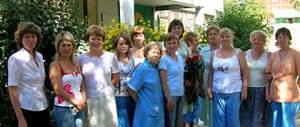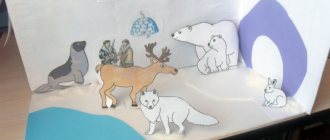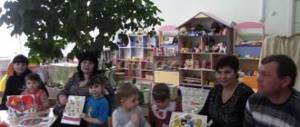Good traditions as one of the methods of raising preschool children
Bibliographic description:
Dokina, E. G. Good traditions as one of the methods of raising preschool children / E. G. Dokina, Yu. G. Hartwig, M. V. Yakurina, N. N. Trunova. — Text: immediate // Aspects and trends of pedagogical science: materials of the II International. scientific conf. (St. Petersburg, July 2020). - St. Petersburg: Own publishing house, 2020. - pp. 27-30. — URL: https://moluch.ru/conf/ped/archive/216/12642/ (date of access: 10.10.2020).
The basis for the creation, strengthening and development of a group of preschoolers is their joint activities aimed at achieving common goals: play, learning, socially useful work, household work, artistic activities, sports, etc. Any activity is an objective factor in the formation of a group.
At all stages of group development, large and small traditions arise, strengthen and unite the team.
Traditions are such stable forms of collective life that emotionally embody the norms, customs, and desires of students.
Group traditions are those that have developed on the basis of long-term experience of joint activities of group members and norms, rules and stereotypes of behavior and actions, everyday communication between people, firmly rooted in their lives, the observance of which has become the need of each member of this group.
The traditions of different groups, however, have a lot in common: national, class, and national traditions permeate each group. Along with the common ones, many specific traditions arise, grow stronger, and exist within each group, which are of great importance for their unity.
The effectiveness and vitality of traditions is determined by the degree of emotional appeal and internal acceptance of them by the group as a whole and by each of its members individually. And this depends on the extent to which a given tradition contributes to the satisfaction of certain subjective needs of people, the extent to which they associate their interests with the action of a particular tradition, and the extent to which ideas about it are associated with social and group ideas and values that are familiar and significant to them.
Traditions help develop common norms of behavior, develop collective experiences, and decorate life.
Traditions can be divided into large and small ones. Great traditions are vibrant mass events, the preparation and holding of which foster a sense of pride in one’s team, faith in its strength, and respect for public opinion. Small, everyday, everyday traditions are more modest in scale, but no less important in their educational impact. They teach how to maintain established order by developing stable habits of behavior. Small traditions do not require special efforts; they are supported by the established order, a voluntarily accepted agreement by all. Traditions change and are updated. New tasks facing the team, new ways of solving them become more or less popular over time - this contributes to the emergence of new traditions and the erasure of old ones.
There are many different methods of uniting a children's group, but the most effective are those that are associated with the introduction of group norms, with the creation of a favorable emotional microclimate in the group, as this will encourage children to want to attend a preschool group, with the organization of the experience of joint activities of children . All these possibilities are implemented in a modern kindergarten, but, in our opinion, methods for creating group traditions, that is, traditions characteristic only of a certain group of preschool educational institutions, deserve special attention.
Folk traditions have existed since time immemorial. Over time, with the development of society, traditions expand, change, some are forgotten, and some, on the contrary, become firmly established in our lives. There are family traditions, corporate traditions, there are traditions that belong to one group, but whatever the traditions are, they are all aimed at uniting people, the desire of people to unite and somehow diversify their lives, decorate them emotionally, bring some positive moments associated with a significant event, with the memory of good deeds. There are traditions in raising children. Basically, these are traditions specific to one particular family. And first of all, in the mind of a small child, the traditions of relationships that exist in the family between parents are deposited; the child develops tastes and habits similar to adults long before the process of realizing what is happening begins. After all, children’s behavior follows the principle of copying.
As the child grows up, he comes to kindergarten and his behavior becomes more conscious. Finding himself in a new environment, a child learns new patterns of behavior and masters forms of human relationships that are new to him. The child begins to develop moral qualities, aspirations, and ideals. And this formation is greatly facilitated by those sometimes unique traditions that exist not only in kindergarten, but specifically in each kindergarten group. Each such tradition is aimed primarily at team unity. And if the teachers in the group adhere to a humane approach to children, where each child is an individual, and everyone together is a friendly team, then it is traditions that help the child master the values of the team, promote a sense of belonging to a community of people, teach them to predict the development of events and choose methods of action. Therefore, creating group traditions in kindergarten and passing them on to the next generation of students is necessary and necessary work. Traditions play a big role in strengthening friendly relations and provide great assistance in raising children. Traditions in which children directly participate together and with the teacher are firmly embedded in children’s memory and are already inextricably linked with childhood, with the memory of kindergarten as a common home, where every child is loved and respected. Our group has already firmly established traditions that have found a response in the hearts of more than one generation of students. These traditions are accepted with great pleasure by children and parents, improved and multiplied. Each tradition is aimed at achieving a specific educational goal. Each tradition is time-tested.
Traditions are a manifestation of the honor of the children's team, and this is their special beauty. They make children feel proud of their team.
Principles for the formation of traditions in a children's team:
- Unconditional acceptance of each child, his strengths and weaknesses.
- Impartiality in assessing the actions of students.
- Patience and tolerance in achieving the goal of pedagogical influence.
- Dialogue in communication with children.
- The teacher is not afraid to admit that he is wrong, his unprofessional actions.
- Using a sense of humor as an integral methodological tool in working with students.
- Eliminating the importance of your mood in communicating with children.
Preschool age is a bright, unique page in the life of every person. It is during this period that the process of socialization begins, the child’s connection with the leading spheres of existence is established: the world of people, nature, the objective world. There is an introduction to culture, to universal human values. The foundation of health is laid. Preschool childhood is the time of initial personality formation. Formation of the foundations of self-awareness and individuality of the child.
Thus, educators are faced with questions: how to make the process of forming a child’s personality creative and exciting, how to achieve success in shaping the development of a preschooler’s personality.
With the innovative development of society and the economy, innovative methods of teaching and educating a comprehensively developed personality have become relevant - methods that are radically different from traditional ones and meet modern requirements.
One of the areas of work in the group is the development of personality, that is, the development of voluntariness and awareness of behavior, responsibility, the ability to cooperate and interact with other children, and the manifestation of the individuality of each child. The activities of children with each other and the interaction of the teacher with children are in the nature of dialogue and active cooperation. We believe that this is important and central to the work of a kindergarten teacher.
The social, linguistic, physical and intellectual potential of our society primarily depends on what is instilled in our children.
Many children do not know how to express their feelings, desires, opinions so that they are understandable to others, understand and accept another point of view, and get out of a conflict with dignity. Therefore, I began to use the good traditions of the group in my work.
“Morning greeting” - children stand in a circle, hold hands and together say certain greetings, which are sometimes accompanied by movements, name themselves and remember absent children. During the “greeting”, the foundations of children’s friendly attitude towards each other are laid, and contact is established between them. They see themselves and others.
Morning greetings are aimed at establishing an atmosphere of trust and community in the group. Developing the ability to interact with peers and adults. Creating a positive mood. Fostering generally accepted norms of greeting. Most of these ritual games are played in a circle. To gather children in a circle, you can use several techniques: “One. Two, three - collect a circle!
“Circle of compliments” is the ability to find “something worthy of praise” in a peer. By giving compliments to a peer, they please both themselves and him: a compliment is an approval of appearance, intelligence, action, work. This instills in the child self-confidence, strengthens his understanding that he is needed and significant in this team.
“A bedtime story” is about creating a good atmosphere at home, warmth, mutual understanding and love.
Children consider “birthday” to be one of the most important days in their lives; they are filled with a sense of anticipation of gifts, congratulations, kind words and wishes. On this day, we devote the first half of the day to honoring the birthday boy. A throne, a cloak, a crown are prepared for the child, and the birthday boy’s booth is decorated. Children come from home with souvenirs made with their own hands or together with their parents. Through the selfless desire to give something to a peer, a personal attitude towards another child is formed, an inner essence that makes deeper interpersonal relationships possible. A sweet table, games, songs, and surprise moments are also organized.
We are also implementing the project “Formation of friendly relations in a group”, taking as a basis the game system developed by Doctor of Pedagogical Sciences E. O. Smirnova. The use of these games contributes to a calm and comfortable microclimate in the group. Children resolve conflict situations on their own, taking into account each other’s interests. The use of games aimed at communication helps children easily adapt to the conditions of kindergarten.
Based on the results of the “Joint Drawing” technique, the kindergarten psychologist notes the features of the group’s joint activities:
– absence of negative assessments of other children; When the drawings were discussed, the children were either interested in what the other person had drawn, or suggested some option for completing the plot;
– the children exchanged pencils easily, at the first request, the children did not separate their drawings from each other, they drew very close, everyone found a place for their drawing without violating the conventional boundaries of the drawings of other children, in general we can say that the interaction was effective, joint the drawing turned out to be meaningful, beautiful, (without aggressive or neurotic lines) and everyone liked it.
Thus, we can say with confidence that the traditions of the group and games of E. O. Smirnova make it possible to make the life of a child in kindergarten attractive and fulfilling, help get rid of accumulated tension, make it possible to feel needed and loved by peers and teachers, and receive the necessary for his emotional well-being a dose of positive emotions.
Literature:
- Vodovozova, E. N. Mental and moral education of children from the first manifestation of consciousness to school age / E. N. Vodovozova. - M.: LIBROKOM, 2012. - 400 p.
- Vologodskaya, O. P. Fostering independence in children. Mom, can I go on my own?! / O. P. Vologodskaya. - M.: Tsentrpoligraf, 2012. - 191 p.
- Gray, D. Children from Heaven: Lessons in Education. How to develop the spirit of cooperation, responsiveness and self-confidence in a child / D. Gray. - M.: Sofia, 2013. - 384 p.
- Kokorina, M. S. Family legal foundations of raising children in modern Russia: Monograph / M. S. Kokorina. - M.: UNITY-DANA, Law and Law, 2011. - 115 p.
- Chernousova, F. P. Spiritual and moral education is the basis for the formation of human needs in a person / F. P. Chernousova. - M.: UTs Perspektiva, 2013. - 120 p.
Key terms
(automatically generated)
: child, tradition, kindergarten, group, raising children, children's team, friend, life, generation of pupils, sense of pride.





